Comforter
Why Does My Down Comforter Smell Like Wet Dog
Wondering why your down comforter smells like wet dog? Discover the reasons behind the unpleasant odor and how to eliminate it effectively.

If your down comforter has a scent reminiscent of wet dog, it is likely due to improper cleaning techniques that have trapped moisture, leading to the development of moldy odors and fungus. The quality of the down material plays a role in the intensity of the odor, so choosing high-quality down can help mitigate this issue. Residues present in the comforter can be activated by moisture, resulting in the unpleasant wet dog smell. To eliminate this odor, consider airing out the comforter in the sunlight or washing it with a solution of vinegar and mild detergent. Utilizing essential cleaning methods is crucial in preventing persistent odors and potential damage. For additional tips on how to maintain and eliminate odors from your down comforter, please refer to the full research.
Key Takeaways
- Trapped humidity in down comforters leads to musty odor similar to wet dog smell.
- Improper cleaning methods activate residues, causing a wet dog scent in down comforters.
- Fungus spores thrive in humid conditions, emitting a strong odor in down comforters.
- Neglecting cleaning can lead to long-term damage and persistent wet dog smell in comforters.
- Quality of down material and proper cleaning techniques are crucial to prevent wet dog odor.
Reasons for the Unpleasant Odor
Unfortunately, our down comforter often smells like wet dog due to improper dry cleaning methods that trap humidity, leading to a moldy odor. The moisture retained within the comforter creates an ideal environment for fungus growth. These fungus spores thrive in humid conditions, emitting a strong wet dog odor that permeates the fabric.
The issue is often exacerbated by the comforter cover, which can trap in the musty smell and make it challenging to eliminate. Neglecting to address this issue can result in long-term damage to the comforter, affecting its quality and lifespan.
To prevent the unpleasant smell resembling wet dog, it's essential to make sure proper dry cleaning methods are employed, allowing the comforter to thoroughly dry and minimizing the risk of fungus growth. Additionally, regularly washing the comforter cover can help in preventing the trapped odor from intensifying.
Taking these steps can maintain the freshness of the comforter and prevent the unwelcome moldy smell from developing.
Impact of Down Material Quality

The quality of the down material in comforters matters greatly. Lower quality down might hold onto more natural odors.
Opting for high-quality down can help prevent strong smells.
Down Material Sources
Exploring the sources of down material reveals how its quality directly influences the presence of unwanted odors in comforters. When considering down material sources, several key factors come into play:
- Quality of the down material
- Cleaning methods employed
- Processing techniques used
- Odor elimination procedures
The quality of down material can vary depending on these factors, impacting the overall freshness of the comforter. Proper cleaning and processing are vital in ensuring that any natural odors are eliminated.
Investing in high-quality down material from reputable sources can greatly reduce the likelihood of your comforter smelling like wet dog. By understanding the importance of down material sources, one can make informed choices to maintain a fresh and pleasant sleeping environment.
Down Quality Standards
Understanding the impact of down material quality on down comforter odor is crucial for maintaining a fresh and pleasant sleeping environment. Down quality standards directly influence the overall odor of a comforter. Higher quality down material undergoes more effective processing and cleaning, reducing potential odors. Inadequate cleaning processes can lead to residual odors lingering in the down material, affecting the comforter's smell. The source and quality of the down feathers used in the comforter play a key role in odor development. Adhering to proper down quality standards guarantees a fresher and cleaner-smelling comforter.
| Factors | Impact on Odor Development |
|---|---|
| Down quality standards | Directly influence comforter odor |
| Cleaning processes | Effective cleaning reduces odors |
| Residual odors | Inadequate cleaning leads to smells |
| Down feathers | Source and quality impact odor |
Residues Activated by Moisture
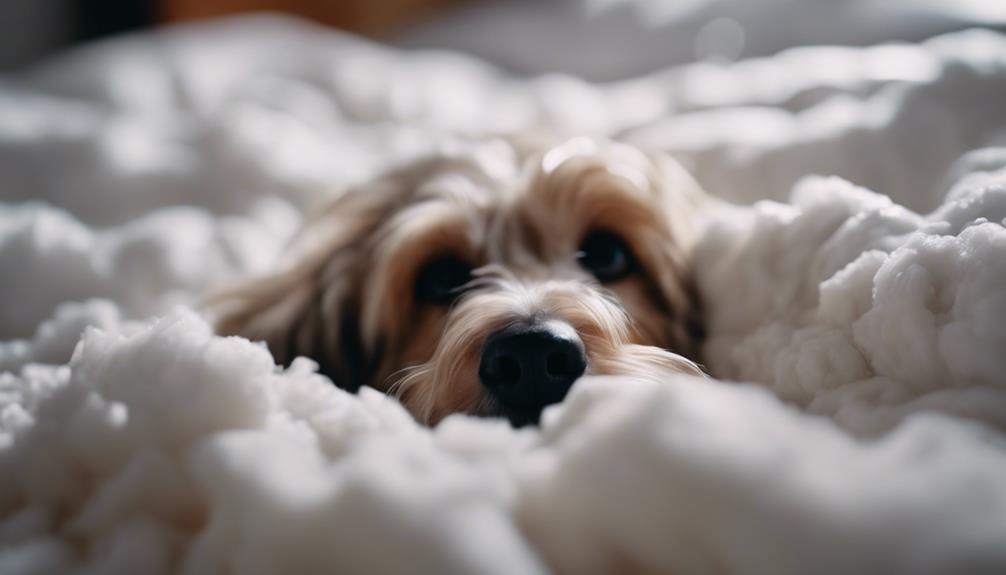
Upon exposure to moisture, residues in down comforters can be activated, resulting in the unwelcome scent reminiscent of wet dog.
- Residues in down comforters can be activated by moisture, leading to the development of unpleasant odors.
- Moisture from various sources can trigger the release of trapped residues, causing a wet dog smell.
- The activation of residues by moisture is a common issue in down comforters that haven't been properly cleaned or dried.
- Humidity in the environment can exacerbate the odor from residues, making it more noticeable.
When moisture interacts with residues in down comforters, it can trigger a pungent scent that resembles wet dog. This issue is often more pronounced in down comforters that haven't undergone thorough cleaning and drying processes. Humidity levels in the surroundings can further amplify the odor, making it harder to ignore.
To prevent this unpleasant smell, it's essential to make sure proper cleaning and drying methods are employed to eliminate residues that could be activated by moisture.
Strategies to Eliminate the Smell
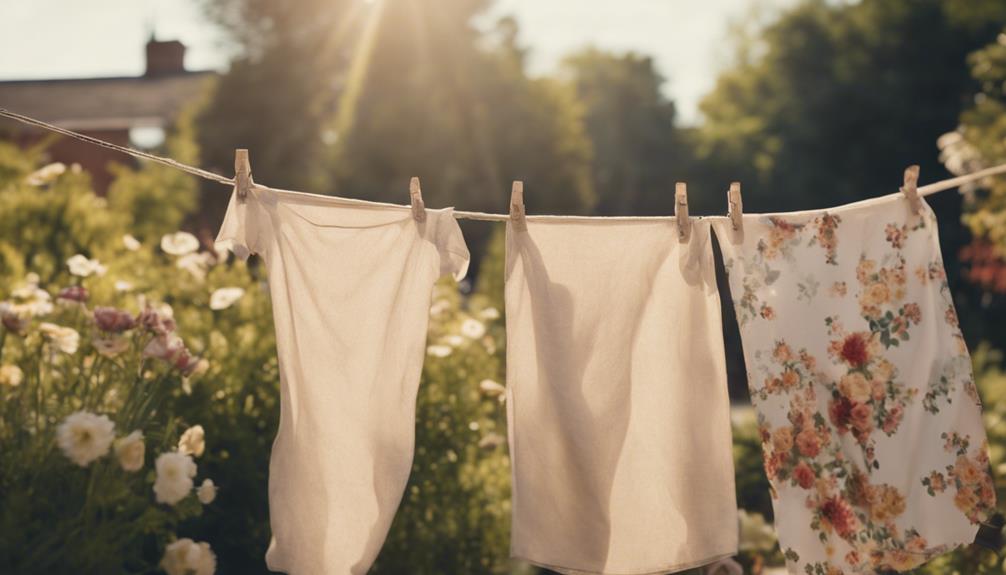
To rid your down comforter of that unpleasant wet dog odor, we can employ various odor removal techniques.
Hanging it outside to air out under the sun can help eliminate the smell.
Washing with vinegar and mild detergent in a delicate setting can also tackle the issue, preventing future odors.
Odor Removal Techniques
Properly airing and sunning your down comforter can effectively eliminate the wet dog smell.
Use baking soda or vinegar in the wash to remove odors.
Consider dry cleaning or professional services for thorough odor removal.
Try scented sachets or dryer sheets to temporarily mask the smell.
Switching to alternative materials may help if the wet dog odor persists.
Preventing Future Smells
To maintain a fresh-smelling down comforter and prevent future odors, focus on airing it out regularly and using protective covers. Make sure to air out the comforter frequently to prevent moisture buildup, which can lead to unpleasant smells.
Using a duvet cover can help shield the comforter from absorbing surrounding odors. Additionally, it's essential to wash and air dry the comforter regularly to maintain its freshness and avoid odors.
Avoid storing the comforter in damp or humid environments as this can cause musty smells to develop. For a temporary solution, consider using fragrance sprays or sachets to mask any lingering odors and keep your down comforter smelling clean.
Importance of Proper Cleaning Methods

Guaranteeing proper cleaning techniques are utilized is essential in eliminating the wet dog smell from a down comforter. To effectively address the issue of a smelly comforter, consider the following:
- Use the Right Detergents: Opt for detergents specifically designed to tackle odors, such as those with enzymes or odor-neutralizing properties.
- Follow Care Instructions: Adhere to the manufacturer's cleaning guidelines to prevent damage and maintain the quality of the comforter.
- Thoroughly Dry the Comforter: Ensure the comforter is completely dry before storing it to prevent mold and mildew growth, which can contribute to unpleasant odors.
- Regular Cleaning Routine: Implement a consistent cleaning schedule to prevent the buildup of odors and maintain a fresh-smelling comforter.
Neglecting proper cleaning methods can't only result in lingering dog odors but also lead to potential damage to the comforter. By following these cleaning tips, you can effectively eliminate the wet dog smell and enjoy a fresh and comfortable sleeping environment.
Maintaining Hypoallergenic Properties
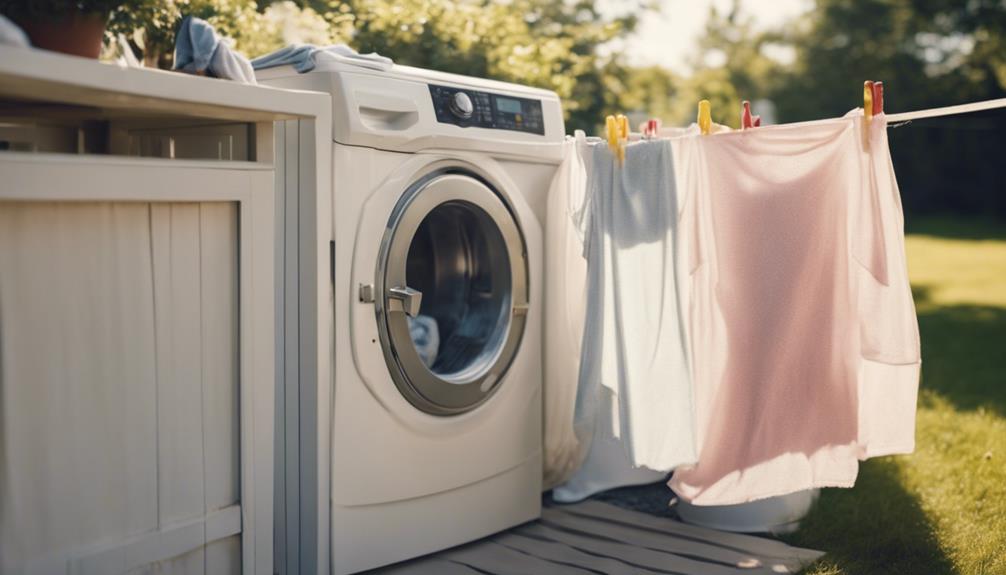
Maintaining the hypoallergenic properties of comforters requires specialized care to preserve their unique allergen-blocking features. To maintain these qualities, it's important to avoid washing hypoallergenic comforters in hot water, as this can damage the special coating that blocks dust mites and dander. Instead, opt for a gentle cycle in the washing machine with cold water.
After washing, air drying the comforter is recommended to prevent any potential heat damage that could affect its hypoallergenic properties. Seeking out French laundries or specialized laundry services can guarantee that the comforter receives the proper care it needs without harsh chemicals that could strip away its hypoallergenic features.
Additionally, using front-loading machines with less water can help reduce drying time, preserving the comforter's hypoallergenic qualities. By following these steps, you can effectively maintain the hypoallergenic properties of your comforter and continue to enjoy its allergen-blocking benefits.
Frequently Asked Questions
How Do You Get Dog Smell Out of a Down Comforter?
To eliminate the dog smell from a down comforter, consider airing it out in sunlight, using baking soda or vinegar during washing, or opting for professional cleaning services.
Scented sachets or dryer sheets can temporarily mask the odor. If the smell persists, replacing the down filling with alternative materials may be necessary.
These methods can help freshen up your comforter and rid it of any lingering dog scent.
Why Does My Down Jacket Smell Like a Wet Dog?
When down jackets smell like wet dogs, it's often due to mold growth from trapped moisture. Fungus spores thrive in humid conditions, causing that unpleasant odor.
To fix it, air dry the jacket outside in the sun or wash it with vinegar and detergent. Neglecting proper drying techniques can lead to long-term damage and lingering odors.
Remember to take care of your down jacket to avoid the wet dog smell!
Why Does My Down Comforter Smell When Wet?
When wet, down comforters can emit a smell similar to wet dog due to trapped humidity fostering fungus growth. This damp environment is ideal for fungus spores, leading to the unpleasant odor.
Neglecting proper drying methods can cause long-term damage and persistent odors. To combat this, follow specific cleaning instructions, air dry in the sun, and make sure thorough washing.
These steps help eliminate the wet dog smell from down comforters and maintain comfort and hygiene.
Why Does My Mattress Smell Like Wet Dog?
Our mattress may smell like wet dog due to trapped moisture, creating a moldy odor. Fungus spores thrive in humid conditions, causing the unpleasant scent.
Neglecting proper cleaning can lead to a lingering smell affecting our sleep quality. To guarantee the odor, we should make sure the mattress is well-aired and use appropriate cleaning techniques.
Ignoring the issue may result in long-term damage and persistent odors.
What Could Cause My Down Comforter to Develop a Foul Smell?
Down comforter odor issues can arise due to moisture buildup from body sweat and oils, or from inadequate air circulation during storage. Regularly airing out and washing your comforter, using natural odor eliminators like baking soda, and ensuring proper storage can go a long way in solving down comforter odor issues.
Conclusion
To sum up, addressing the unpleasant odor of a down comforter smelling like wet dog requires proper cleaning methods and maintenance.
Just like a well-tended garden blooms with vibrant flowers, a well-cared-for down comforter retains its cozy warmth without any unwanted scents.
Remember, a little care goes a long way in keeping your comforter fresh and inviting for a good night's sleep.
Mason – Your Product Expert Mason is your go-to product expert, carefully selecting each item in our collection to ensure it meets your comfort, functionality, and style needs. With his attention to detail and commitment to quality, he ensures that every product we offer enhances your home experience.
Comforter
Can You Use a Down Comforter as a Mattress Topper
Hesitant about using a down comforter as a mattress topper? Find out why it may not be the best choice for optimal comfort and support.
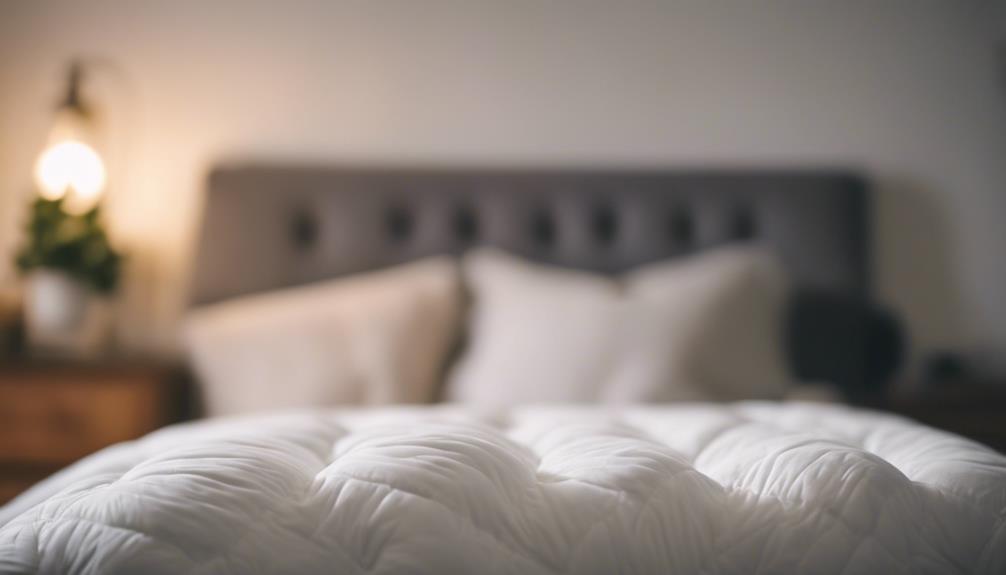
Using a down comforter as a mattress topper may not provide the optimal comfort and support. Down comforters are not as thick or structured as proper mattress toppers, which can result in uneven warmth distribution and insufficient cushioning for pressure relief. Additionally, their sizing may not align with the mattress, leading to an ill fit. Unlike toppers, down comforters are designed primarily for warmth rather than support. It is recommended to learn more about the distinctions between comforters and toppers to improve the quality of your sleep.
Key Takeaways
- Down comforters lack the support and thickness of a mattress topper.
- Using a down comforter may lead to uneven warmth distribution.
- Down comforters may not provide adequate cushioning for pressure relief.
- Size and dimensions may not align well with the mattress.
- Down comforters are not engineered for optimal support as mattress toppers.
Reasons to Avoid Using a Down Comforter
Using a down comforter as a mattress topper presents several drawbacks that should be considered before making this choice.
A down comforter lacks the necessary thickness and support to effectively function as a mattress topper. This lack of support can lead to an uneven distribution of warmth and comfort, potentially causing discomfort while sleeping.
Additionally, down comforters are primarily designed for insulation purposes and may not provide the cushioning needed for proper pressure relief on a mattress.
The size and dimensions of a down comforter may also not align correctly with those of a mattress, resulting in an ill-fitting topper that can shift during the night.
Please note that down comforters aren't specifically engineered to offer the best support and comfort required for a mattress topper, which could impact the overall sleeping experience negatively.
Differences Between Comforters and Toppers
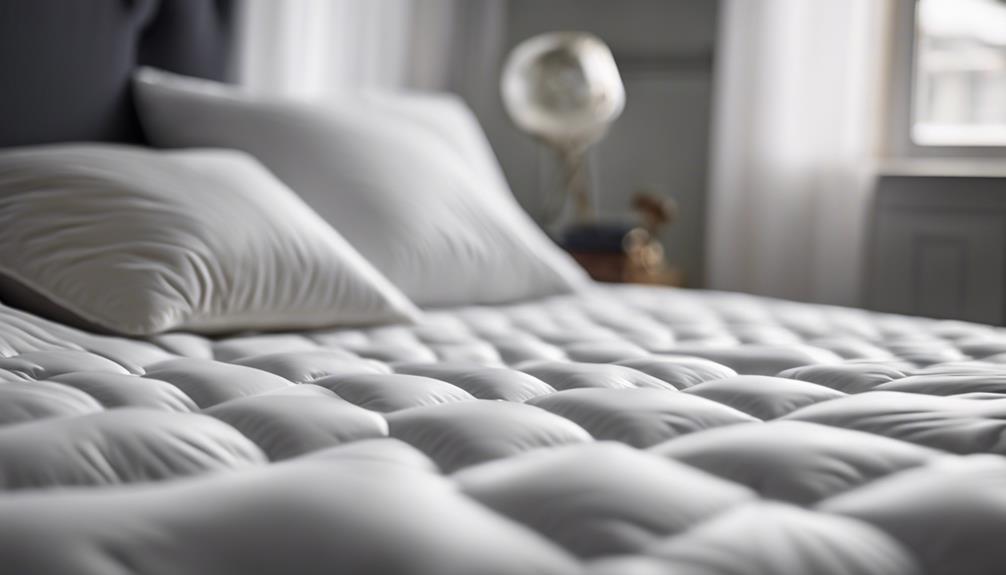
When comparing down comforters and mattress toppers, it's important to understand the distinct purposes each serves in enhancing the sleeping experience. A down comforter is typically larger and thicker than a mattress topper, providing more warmth and insulation. Comforters are designed to be used as blankets on top of the bed, while toppers are meant to enhance the comfort of the mattress.
While down comforters offer coziness and warmth, they may not provide the same level of support or pressure relief as a specialized mattress topper. Toppers are specifically crafted to improve the feel and support of the mattress, focusing on enhancing comfort and support. Using a down comforter as a mattress topper may not optimize the benefits that a dedicated topper can offer in terms of comfort and support.
Therefore, understanding the differences between these bedding essentials can help individuals make informed decisions on how to best enhance their sleep quality.
Importance of Support and Cushioning
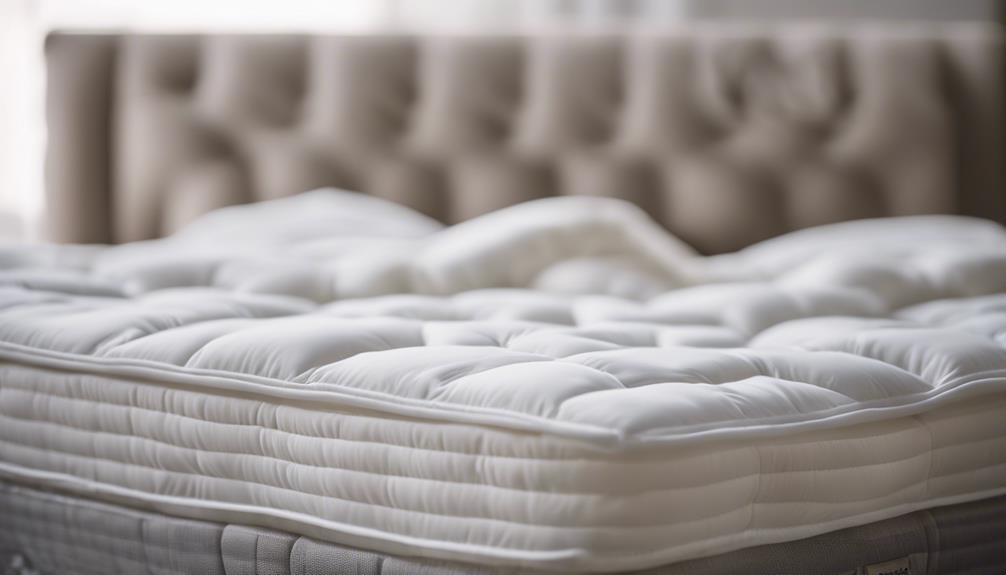
Adding a down comforter to your mattress can greatly enhance the support and cushioning for a more comfortable sleeping experience.
The extra layer of softness and warmth provided by the down comforter can make your bed feel cozier and more inviting.
This added cushioning can help alleviate pressure points, allowing you to sink into a more luxurious and comfortable sleep.
Not only does using a down comforter as a mattress topper increase comfort, but it can also extend the life of your mattress by acting as a protective barrier.
The insulating properties of a down comforter help regulate body temperature, ensuring you stay comfortable throughout the night, which is essential for a restful sleep.
Down Comforter Vs. Mattress Topper Functionality
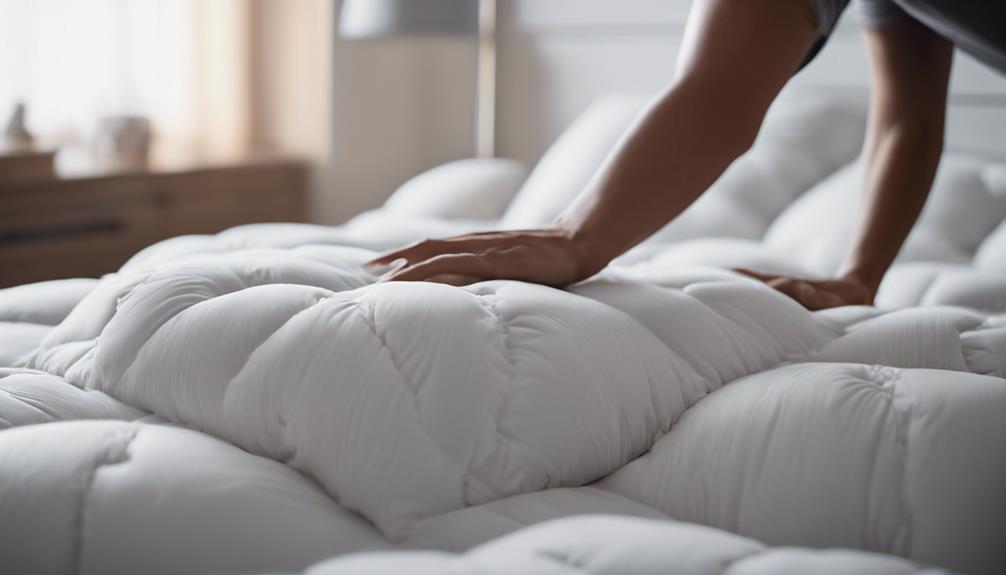
When considering functionality differences between a down comforter and a mattress topper, it's crucial to acknowledge that a comforter can add softness but may lack the support of a specialized topper.
While a down comforter can enhance comfort with its plush surface, a mattress topper is designed to provide additional benefits like targeted cushioning and support for the body.
Understanding the unique advantages of each can help in making an informed decision on how to improve sleep quality.
Functionality Differences Explained
Functionality differs between a down comforter and a mattress topper due to their distinct purposes and designs. Mattress toppers are specifically crafted to enhance comfort and support on a mattress. They're smaller than down comforters and are placed directly on the mattress under a fitted sheet.
In contrast, down comforters are primarily used as blankets for warmth and insulation, covering the entire bed. The thickness and weight of down comforters may not be suitable for use as a mattress topper, which requires a balance of cushioning and support.
Mattress toppers are designed with specific materials and structures to provide targeted support and comfort for sleeping, while down comforters prioritize warmth and coziness over support and pressure relief.
Comforter as Topper Pros
In our experience, utilizing a down comforter as a mattress topper can enhance the overall warmth and comfort of your bed. A down comforter can provide a plush and luxurious feel, similar to a traditional mattress topper.
These comforters are lightweight yet offer excellent insulation, making them a great choice for colder nights. While a down comforter may lack the same support and thickness as a specialized mattress topper, it can still be a cozy addition to your bedding.
It's crucial to take into account the size and weight of the down comforter to make sure it fits comfortably on your bed. Overall, using a down comforter as a topper can elevate your sleeping experience by adding an extra layer of softness and warmth.
Mattress Topper Benefits
We can appreciate the versatility that a down comforter offers when utilized as a mattress topper, enhancing both the comfort and warmth of our sleep environment.
Down comforters typically have a higher fill power than regular mattress toppers, providing superior insulation. This means that when used as a mattress topper, a down comforter can offer exceptional warmth and coziness.
The extra layer of softness it adds can greatly improve the overall comfort of your bed. Additionally, down comforters are easy to place on top of your mattress, instantly elevating the luxury and comfort of your sleep space.
Impact on Sleep Quality

Adding a down comforter as a mattress topper can greatly impact sleep quality.
The extra layer of softness and comfort enhances overall sleep comfort, while the additional insulation helps regulate temperature, especially during colder nights.
Alleviating pressure points on the body leads to a more restful and rejuvenating sleep experience.
Sleep Comfort Impact
Enhancing sleep quality, a down comforter used as a mattress topper provides an extra layer of softness and comfort. The down comforter's added insulation can help regulate body temperature, leading to better sleep on colder nights.
It offers pressure relief and support, reducing discomfort and enhancing overall sleep comfort. The plushness creates a cozy sleep environment that promotes relaxation and restful sleep.
Adding a down comforter as a mattress topper can elevate the luxurious feel of your bed, making it a welcoming space for quality sleep.
Temperature Regulation Benefits
The temperature regulation benefits of using a down comforter as a mattress topper greatly impact sleep quality, ensuring comfort and excellent rest throughout the night. Down comforters excel at keeping you warm in winter and cool in summer, thanks to their natural insulation. These comforters trap heat to provide coziness during chilly nights and wick away moisture and sweat, creating a dry sleep environment. Their breathability allows for proper air circulation, preventing overheating and ensuring a comfortable sleep experience. By adapting to your body temperature, down comforters enhance sleep quality by providing a cozy and comfortable surface.
| Benefits of Using a Down Comforter as a Mattress Topper |
|---|
| Excellent temperature regulation |
| Natural insulation for warmth in winter and coolness in summer |
| Moisture and sweat-wicking properties |
| Breathability for air circulation and prevention of overheating |
| Adaptability to body temperature for enhanced sleep quality |
Benefits of Using a Proper Mattress Topper
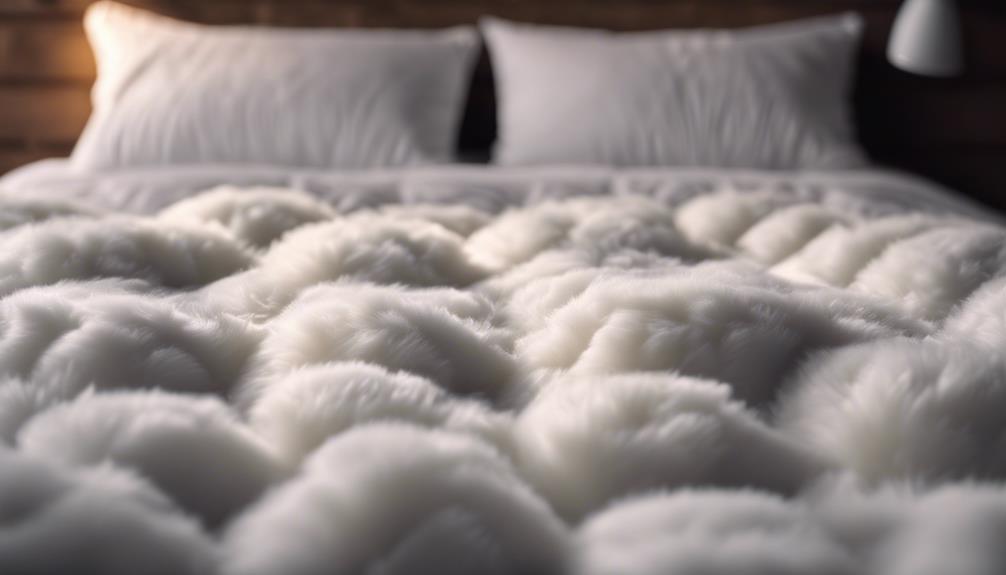
Using a proper mattress topper can greatly enhance the comfort and support of your bed. A mattress topper, such as a down comforter, adds an extra layer of softness and cushioning to your sleeping surface. This additional padding can help relieve pressure points, promoting a more restful sleep experience.
Moreover, a mattress topper can assist in regulating body temperature by providing warmth during colder months and cooling effects in warmer seasons. For individuals with allergies or sensitivities, a down comforter mattress topper offers hypoallergenic properties due to its natural materials.
Additionally, by acting as a protective barrier, a mattress topper can prolong the lifespan of your mattress by minimizing wear and tear. Overall, investing in a proper mattress topper like a down comforter can bring multiple benefits, ranging from improved comfort and support to better sleep quality and mattress longevity.
Longevity and Maintenance Considerations
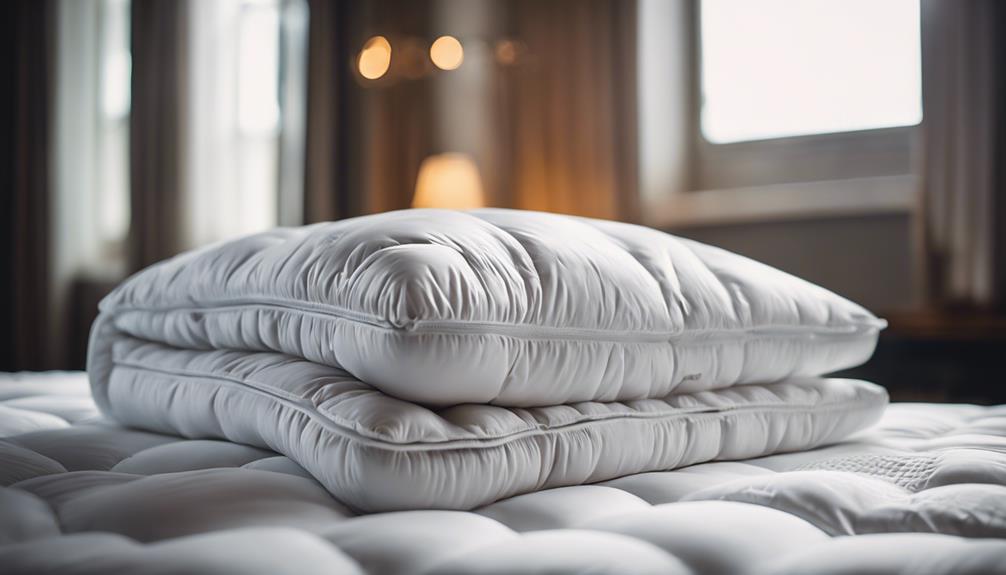
To guarantee the lasting quality and performance of a down comforter used as a mattress topper, regular maintenance practices are crucial. This includes spot cleaning any stains promptly and rotating the comforter to promote even wear. Placing a mattress protector over the down comforter can further help prevent wear and tear, keeping it in good condition for a longer period.
While some feathers may escape over time, proper care and maintenance can greatly extend the lifespan of your down comforter mattress topper. By investing a little time in caring for your bedding, you can enjoy the benefits of added cushioning and comfort while also protecting your mattress. Remember that a small effort in maintenance can go a long way in preserving the quality and longevity of your down comforter mattress topper.
Conclusion: Choosing the Right Bedding Accessories
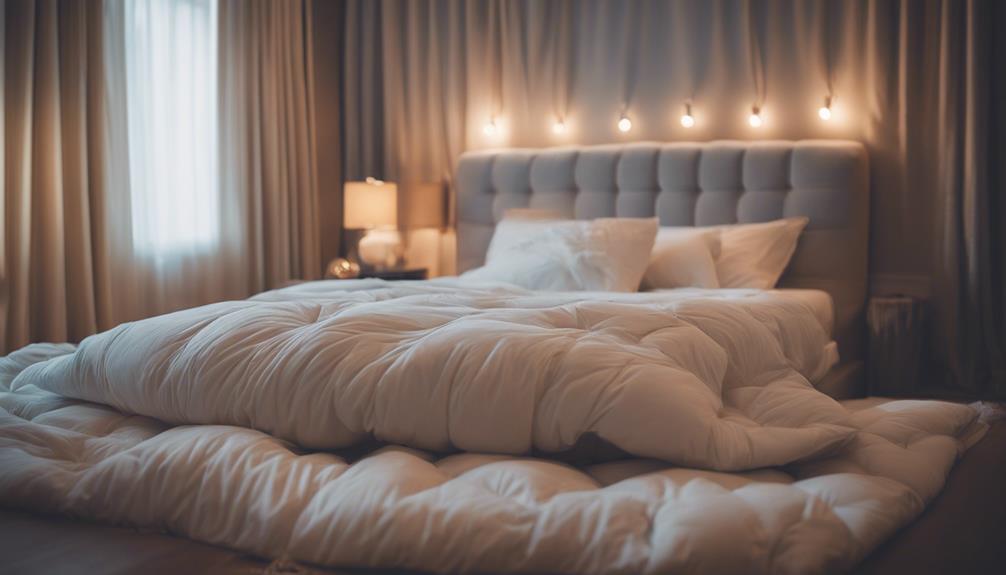
When selecting bedding accessories, consider the overall aesthetic and comfort level they'll bring to your bedroom. A down comforter can serve as a luxurious mattress topper, providing extra cushioning and coziness. These comforters are lightweight and soft, making them perfect for adding a layer of plush comfort to your bed.
Make sure that the down comforter is large enough to cover the entire surface of your mattress for best coverage. To prevent shifting during sleep, you may need to secure the comforter in place with duvet clips or straps. Down comforters are versatile bedding accessories that offer warmth in winter and a luxurious feel year-round when used as a topper.
When choosing bedding accessories like a down comforter as a topper, prioritize both functionality and style to create a comfortable and visually appealing bedroom space.
Frequently Asked Questions
Can You Use a Comforter as a Mattress Topper?
Yes, using a comforter as a mattress topper isn't recommended. Comforters are designed for warmth and coverage, not for enhancing mattress comfort. They may not provide the necessary support and could lead to uneven weight distribution.
It's best to use a dedicated mattress topper for improving comfort and support. This guarantees better sleep quality and prolongs the lifespan of your mattress.
What Can I Use Instead of a Mattress Topper?
When selecting alternatives to a mattress topper, we can explore various options for added comfort and support. Memory foam pads, mattress enhancers, or even a thick quilted blanket are some possibilities to consider.
These substitutes can offer similar benefits to mattress toppers by enhancing the feel of your bed and improving sleep quality.
Selecting a material that aligns with your preferences and sleeping habits is crucial for optimal comfort and support.
Is Down Good for a Mattress Topper?
Yes, down is an excellent choice for a mattress topper. It offers exceptional comfort, insulation, and adjusts to your body contours, providing support and pressure relief for a cozy night's sleep.
Down's natural insulating properties keep you warm in winter and cool in summer, enhancing the overall softness and luxury of your bed. It's a plush layer that can make your sleeping experience feel like a dream.
Can I Use a Feather Duvet as a Mattress Topper?
Yes, we can use a feather duvet as a mattress topper. They add comfort and softness to the bed, enhancing its plushness. Feather duvets are lightweight and conform to body shape for a cozy sleep.
Consider the fill power and material for best comfort and support. It's a great way to make your bed more comfortable and snug.
Is It Necessary to Use a Duvet Cover if Using a Down Comforter as a Mattress Topper?
Yes, it is necessary to use a duvet cover for a down comforter used as a mattress topper. The duvet cover protects the down comforter from stains, dirt, and damage, while also providing an additional layer of warmth and comfort. Using a duvet cover for a down comforter is essential for maintaining its quality and prolonging its lifespan.
Conclusion
To sum up, using a down comforter as a mattress topper is like trying to wear a hat as shoes – it's just not the right fit. Mattress toppers provide the necessary support and cushioning for a good night's sleep, while comforters are designed for warmth and insulation.
Investing in a proper mattress topper won't only improve your sleep quality but also extend the longevity of your mattress. Choose the right bedding accessories for a comfortable and restful sleep experience.
Mason – Your Product Expert Mason is your go-to product expert, carefully selecting each item in our collection to ensure it meets your comfort, functionality, and style needs. With his attention to detail and commitment to quality, he ensures that every product we offer enhances your home experience.
Comforter
Do You Need a Duvet Cover for a Down Comforter
Cover your down comforter with a duvet cover for protection, warmth, and style – discover why it's a must-have!
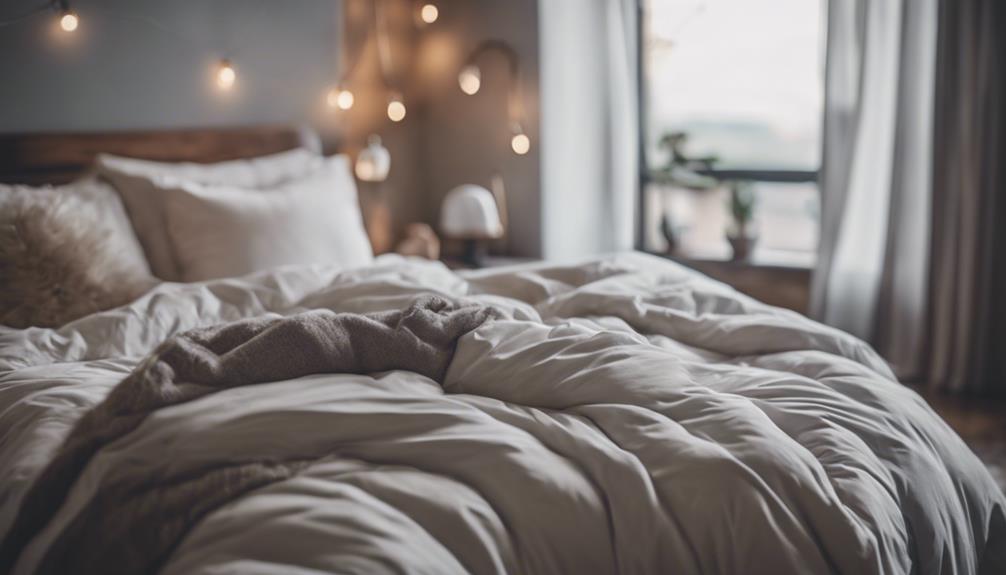
To ensure your down comforter stays protected and lasts longer, it is important to use a duvet cover. Duvet covers help shield comforters from dust, allergens, and oils, which ultimately extends their durability. Additionally, they provide an extra layer of warmth and come in a variety of colors and patterns to enhance the visual appearance of your bedding. Opting for ready-made bedding with built-in covers can also provide a convenient solution. With benefits such as texture enhancement and simplified cleaning, duvet covers are an essential item. For more information on the advantages and features of down comforter covers, browse our selection of down comforters.
Key Takeaways
- Duvet covers protect down comforters from dust, allergens, and oils, extending their lifespan.
- Covers enhance the visual appeal of bedding with various colors and patterns.
- Using a cover simplifies cleaning, prevents shedding, and improves texture.
- Covers provide an extra layer of protection for the comforter, offering increased warmth.
- Ready-to-use bedding with built-in covers offers a hassle-free solution.
Down Comforters Typically Come With Cover
When shopping for a down comforter, it's important to keep in mind that they typically come with a cover already sewn on. This feature eliminates the need for an additional duvet cover, saving you time and money.
The cover of a down comforter serves multiple purposes beyond just aesthetics. Not only does it come in various colors, patterns, and designs to match your bedroom decor, but it also provides an extra layer of protection for the comforter itself. These covers are designed to be durable and easy to maintain, ensuring that your comforter stays in top condition for years to come.
Additionally, down comforters with covers sewn on are often more cumbersome, offering increased warmth without the hassle of dealing with a separate duvet cover. With a wide range of designs available, you can easily find a down comforter that complements your bedroom style while providing cozy comfort for a good night's sleep.
Benefits of Using Down Comforters

If you're looking to experience the luxurious warmth and comfort of down comforters, you'll appreciate the many benefits they offer. Down comforters provide exceptional insulation while feeling lightweight, offering a cozy night's sleep. These comforters are designed to regulate body temperature, ensuring you stay warm in the winter and cool in the summer. The natural properties of down feathers make these comforters durable, long-lasting, and resistant to clumping, maintaining their quality over time.
Additionally, using a duvet cover with your down comforter can further enhance its longevity and protect it from wear and tear. Duvet covers not only add a stylish touch to your bedding but also provide an extra layer of protection for your comforter. By combining the benefits of down comforters with the added protection and style of duvet covers, you can create a comfortable and inviting sleeping environment for yourself.
Aesthetics and Protection of Cover

Duvet covers not only enhance the visual appeal of your bedding but also provide essential protection for your down comforter. These covers come in various colors and patterns, allowing you to change the look of your bedroom easily. When selecting a duvet cover, consider materials like cotton for a soft and breathable option. A higher thread count in the cover can offer a smoother finish and increased durability.
In addition to aesthetics, duvet covers play an important role in safeguarding your down comforter. They shield the comforter from dust, allergens, and skin oils, extending its lifespan. For those with feather-filled comforters, covers prevent shedding issues, keeping your bedding clean and comfortable. Additionally, the cover's presence improves the overall texture of the duvet casing, providing a luxurious feel for a better night's sleep. By combining style and protection, duvet covers are a practical and stylish addition to any bedding ensemble.
Convenience of Ready-to-Use Bedding
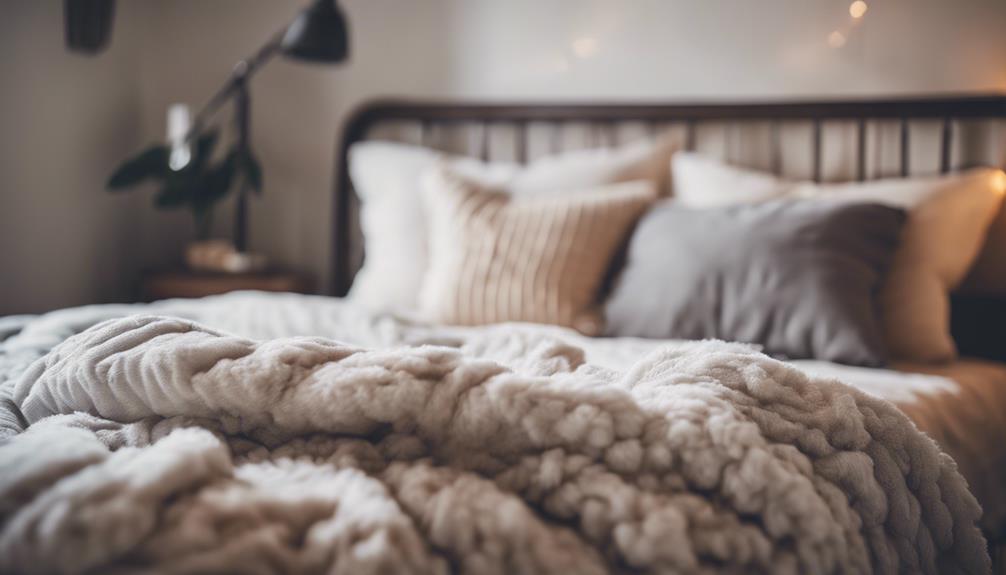
Ready-to-use bedding offers a hassle-free solution for those seeking convenience in their bedroom decor. Down comforters, with their cover already sewn on, provide a complete bedding option without the need for an extra duvet cover. This built-in feature guarantees a finished look, saving time and effort. These comforters come in various colors, patterns, and designs, catering to different bedroom aesthetics. Here is a table highlighting the convenience of ready-to-use bedding:
| Convenience of Ready-to-Use Bedding | Description | Benefit |
|---|---|---|
| Built-in Cover | Cover sewn on the comforter | Saves time and effort |
| Variety of Designs | Comes in various colors, patterns, designs | Matches different bedroom aesthetics |
| Complete Bedding Solution | No need for an extra duvet cover | Provides a seamless and hassle-free bedding option |
Choosing a down comforter with a built-in cover can simplify your bedding routine while adding style to your bedroom.
Features of Down Comforter Covers
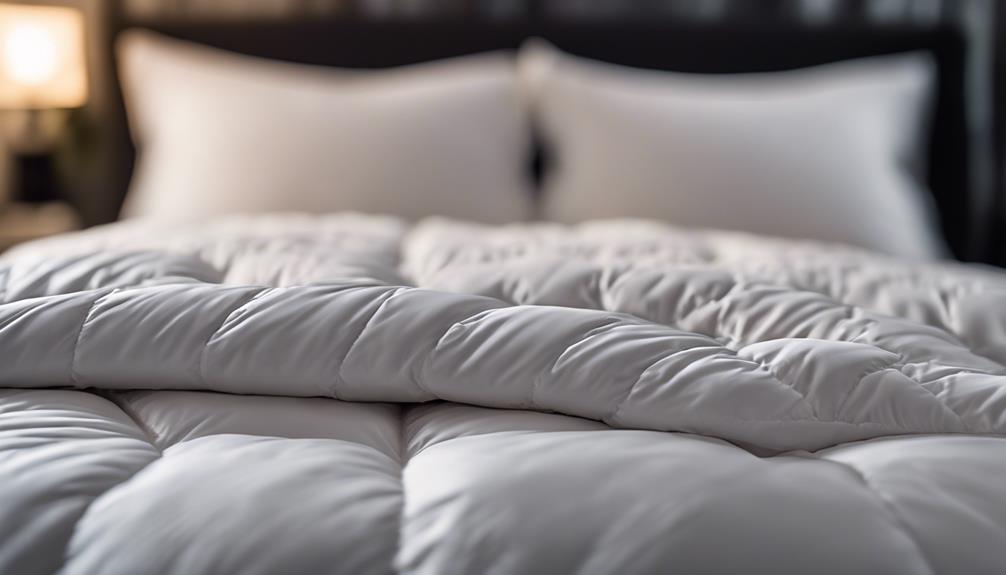
Down comforter covers provide benefits such as protecting the comforter, enhancing texture, and elevating the bedding's aesthetic appeal. Maintenance tips for these covers guarantee longevity and quality.
Style options like percale and sateen offer varied choices to suit different preferences and needs.
Benefits of Covers
Enhancing the longevity and protection of down comforters, covers play a crucial role in maintaining the quality and cleanliness of bedding.
Down comforter covers provide an extra layer of protection, preventing shedding and keeping the feathers intact. They make cleaning simple without wetting the feathers, ensuring the comforter stays in good condition.
Additionally, these covers improve the texture of the duvet casing, enhancing overall comfort.
Not only do duvet covers offer practical benefits, but they also add aesthetic appeal to the bedding, enhancing the décor of the bedroom.
Maintenance Tips
When selecting a down comforter cover, consider opting for high-quality Egyptian cotton for a softer and more breathable surface. Proper cover maintenance is essential for preserving the quality of your down comforter. Here are some tips to help you care for your cover and comforter effectively:
| Maintenance Tip | Description |
|---|---|
| Regular Washing | Wash the cover frequently to keep it clean. |
| Gentle Drying | Dry the cover on low heat to prevent damage. |
| Spot Cleaning | Address spills promptly to avoid stains. |
| Storage | Store the cover in a breathable bag when not in use. |
Following these maintenance tips will ensure that your down comforter and cover remain in good condition for a long time.
Style Options
To explore the various style options available for down comforter covers, it's essential to contemplate features such as closure types, construction designs, and fabric choices that can enhance both the aesthetics and functionality of your bedding.
When selecting a down comforter cover, consider the following:
- Closure Types: Opt for a zipper closure for convenience and a sleek look.
- Construction Designs: Look for hidden button closures for durability and ease of use.
- Fabric Choices: Choose washable cotton fabric for easy maintenance and a comfortable feel.
Our Fine Selection of Down Comforters

Our down comforters are crafted with high-quality down feathers for a luxurious feel. They offer excellent insulation and warmth for a cozy night's sleep.
With a variety of sizes and fill weights available, there's a perfect match for every preference and need.
Down Comforter Benefits
Among our fine selection of down comforters, you'll find luxurious warmth and superior insulation for a restful night's sleep. Here are some benefits of our down comforters:
- High fill power down provides excellent insulation.
- Durable and long-lasting, offering great value.
- Smooth cotton coverings guarantee a soft and cozy feel.
Investing in a down comforter enhances your overall sleep experience with superior warmth and comfort. Our selection of down comforters is designed to provide you with the quality and coziness you deserve for a peaceful night's rest. Experience the luxury and comfort of our down comforters for yourself and elevate your bedding to a whole new level of relaxation.
Choosing the Right Size
When selecting a down comforter size, it's important to take into account the dimensions of your bed to guarantee proper coverage and a cohesive look for your bedding ensemble.
Whether you have a twin, full, queen, or king size mattress, choosing the right size down comforter is essential.
For a king-size bed, make sure you pick a duvet that matches its dimensions to avoid issues like overhang or inadequate coverage.
A well-fitting down comforter not only enhances the overall appearance of your bed but also adds to the comfort of your sleep environment.
Consider the size of your bed carefully when selecting a down comforter to achieve both practicality and aesthetic appeal.
Care and Maintenance Tips
To keep your down comforter in prime condition, regularly fluffing and airing it out is essential to maintain its loft and freshness. Here are some care and maintenance tips for your down comforter:
- Spot clean promptly: Address any stains on your down comforter promptly to prevent them from setting.
- Use a duvet cover: Protect your down comforter from dust, dirt, and allergens by using a duvet cover for easier maintenance.
- Follow care instructions: Avoid washing your down comforter frequently to preserve its loft. Follow the manufacturer's care instructions for cleaning to safeguard its longevity and performance.
Frequently Asked Questions
Can You Use a Down Comforter Without a Duvet Cover?
Yes, it's possible to use a down comforter without a duvet cover. However, it's not recommended for protection and longevity.
Duvet covers shield down comforters from dust, oils, and stains, extending their lifespan. Without a duvet cover, down comforters may get dirty more quickly and require more frequent cleaning.
Duvet covers offer a convenient and washable protective layer, enhancing comfort, cleanliness, and overall bedding experience.
Do You Need a Duvet Cover for a Comforter?
Yes, a duvet cover is essential for a down comforter. It protects the comforter from dust, allergens, and oils. Washing a duvet cover is easier than washing the down comforter itself, prolonging its lifespan.
Additionally, using a duvet cover enhances the overall comfort of your bedding. Not only does it offer practical benefits like protection and easy cleaning, but it also adds aesthetic appeal to your bedroom decor.
Why Do You Put a Duvet Over a Comforter?
We put a duvet over a comforter to protect it from dust, allergens, and skin oils. Washing a duvet cover is easier than washing a down comforter, preserving its lifespan.
Duvet covers enhance the sleeping experience by adding comfort and cleanliness. Additionally, they improve the aesthetic appeal of bedding.
Do You Put Something Over a Down Comforter?
Yes, you should put something over a down comforter. A duvet cover is ideal for protecting your comforter and adding style to your bedding. It keeps the comforter clean and can be easily washed.
Using a duvet cover enhances the comfort and appearance of your bed while prolonging the lifespan of your down comforter. So, investing in a duvet cover is a smart choice to maintain your bedding's quality.
Is it necessary to use a duvet cover for a down comforter?
Yes, a down comforter cover is needed to protect your investment. Not only does it keep your comforter clean, but it also helps to extend its lifespan. A duvet cover is also a great way to change up the look of your bedding without having to buy a whole new comforter.
Conclusion
To sum up, having a duvet cover for a down comforter isn't a necessity, but it does offer several benefits. It can help protect your comforter, enhance the aesthetics of your bedding, and provide added convenience with ready-to-use bedding.
Additionally, down comforter covers come in a variety of styles and features to suit your needs.
Overall, investing in a duvet cover for your down comforter can enhance your sleeping experience and prolong the life of your bedding.
Mason – Your Product Expert Mason is your go-to product expert, carefully selecting each item in our collection to ensure it meets your comfort, functionality, and style needs. With his attention to detail and commitment to quality, he ensures that every product we offer enhances your home experience.
Comforter
Can You Wash a Down Comforter With an Agitator
Juggling between washing a down comforter with an agitator? Find out how this impacts your bedding's fluffiness and durability.
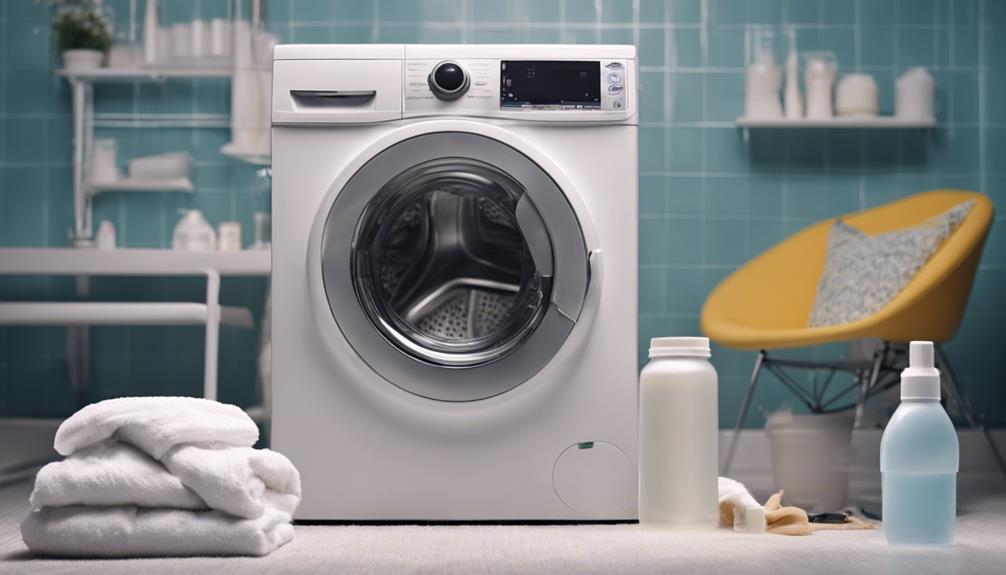
When you wash a down comforter with an agitator, it can damage the fluffiness and durability of the bedding. The rough treatment could cause clumping, uneven filling distribution, and harm delicate down clusters. Agitators may affect the comforter’s loft and warmth, impacting its overall quality. Front-load washers are a superior option for upholding the comforter’s integrity. Utilizing a machine without an agitator aids in preserving the down fill. Adhere to care instructions, use mild detergent, and avoid overloading the machine for optimal outcomes. Safeguard your delicate comforter by selecting the appropriate washing machine.
Key Takeaways
- Avoid washing a down comforter with an agitator to prevent clumping and damage to delicate filling.
- Agitators can break down clusters, reduce loft, and harm comforter insulation.
- Opt for front-load washers for gentle, even cleaning without compromising fluffiness.
- Front-load washers maintain comforter quality by preventing damage to down fill.
- Using a machine without an agitator preserves the longevity and fluffiness of the down comforter.
Risks of Washing Down Comforter With Agitator
When washing a down comforter with an agitator, it's important to be mindful of the risks involved to prevent damage and maintain its quality. Agitators in washing machines can be harsh on delicate down fibers, potentially causing clumping and loss of fluffiness in the comforter.
The twisting and turning motion of an agitator can create stress on the fabric and stitching of the comforter, increasing the risk of tears or damage during the wash cycle. This rough handling can lead to uneven distribution of the down fill, impacting the overall comfort and warmth provided by the comforter.
To preserve the quality and longevity of your down comforter, it's recommended to opt for a washing machine without an agitator. By avoiding the use of an agitator, you can guarantee that your comforter remains in top condition for years to come.
Impact of Agitator on Down Filling

Agitators in washing machines can harm the delicate down filling of a comforter, potentially causing clumping or shifting of the down. This can affect the loft and warmth of the comforter, as the down may not be evenly distributed.
It's advisable to choose a washing machine without an agitator to safeguard the quality and integrity of the down filling in the comforter.
Agitator and Down Quality
To maintain the quality of down fillings in a comforter, it's crucial to avoid washing it in a machine with an agitator. Agitators in washing machines can harm the delicate down clusters by causing them to break, which reduces the comforter's loft and insulation.
Down comforters are best suited for machines without agitators to preserve their quality. The harsh agitation from an agitator may lead to clumping and uneven distribution of down within the comforter.
Opting for a machine without an agitator guarantees gentle cleaning, preserving the integrity of the down comforter. Remember, choosing the right washing machine can make a significant difference in prolonging the lifespan of your cozy down comforter.
Down Clumping Concerns
After considering the potential harm to down fillings caused by agitators, it becomes evident that clumping is a significant concern during the washing process. Agitators in washing machines can lead to the down filling sticking together, which may result in an uneven distribution within the comforter. This uneven distribution can impact the warmth and comfort provided by the comforter.
Additionally, the delicate down clusters can be damaged by the agitator, reducing the loft and fluffiness of the comforter over time. To maintain the quality and longevity of a down comforter, it's advisable to use a front-load or top-load high-efficiency washer without an agitator. This approach helps preserve the loft and quality of the down filling within the comforter.
Best Washer Types for Down Comforters

Front-load washers are recommended for washing down comforters to prevent damage to the delicate down fill. The gentle tumbling action of front-load washers is ideal for maintaining the fluffiness and loft of the comforter. Unlike top-load washers with agitators that can cause clumping and uneven distribution of water and detergent, front-load washers guarantee a more thorough and even cleaning process. The absence of an agitator in front-load washers reduces the risk of damaging the delicate down clusters, resulting in a cleaner and better-maintained down comforter.
Front-load washers are designed to handle bulkier items like down comforters more effectively, thanks to their spacious drum capacity. This allows the comforter to move freely during the wash cycle, promoting better cleaning and rinsing. While top-load washers without agitators can also be a gentler alternative for washing down comforters, front-load washers are generally preferred for their efficiency and effectiveness in preserving the quality of the down fill.
Alternatives to Agitator Washing
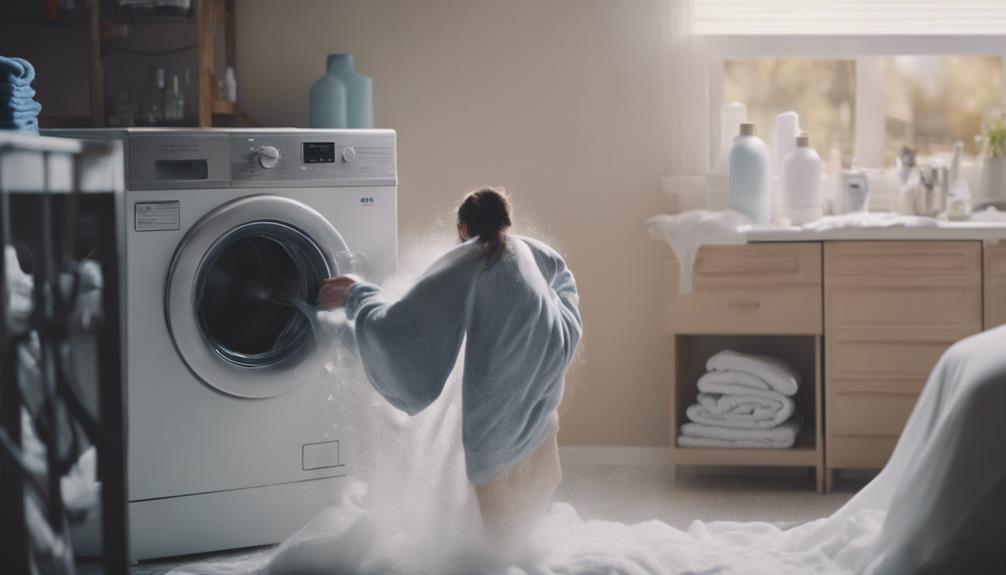
When looking for alternatives to agitator washing, consider front-load washers as a gentler option for cleaning down comforters. These machines provide better water distribution and are less likely to damage delicate down fill.
Opting for a front-load washer can help maintain the integrity and loft of your down comforter over time.
No Agitator Needed
To safeguard the delicate down clusters in your comforter, opting for a washing method that doesn't involve an agitator is essential. Front-load washers are a great alternative, providing a gentle washing action that helps maintain the fluffiness and longevity of your down comforter. Here's a comparison to highlight the benefits of using a front-load washer:
| Aspect | Front-Load Washer | Top-Load Washer |
|---|---|---|
| Agitator Presence | No | Yes |
| Gentle Washing | Yes | No |
| Preservation of Down | Effective | Risk of damage |
| Suitability | Ideal for down comforters | Less ideal |
Choosing a front-load washer can help guarantee your down comforter remains in top condition without the risks associated with agitator washing.
Gentle Care Methods
Using a bathtub for hand washing and air drying can provide a gentle alternative to using an agitator for washing delicate down comforters. This method helps prevent damage that agitators in top-load washers can cause.
When washing a down comforter by hand, it's crucial to use cold water and a mild detergent, gently agitating the comforter without wringing it. Placing the comforter in a duvet cover before washing can also provide an extra layer of protection.
Additionally, air drying the comforter flat can guarantee it maintains its loft and fluffiness. If a top-load washer without an agitator or a front-load washer is available, using these can be other gentle care methods for washing down comforters effectively.
Professional Cleaning Vs. DIY
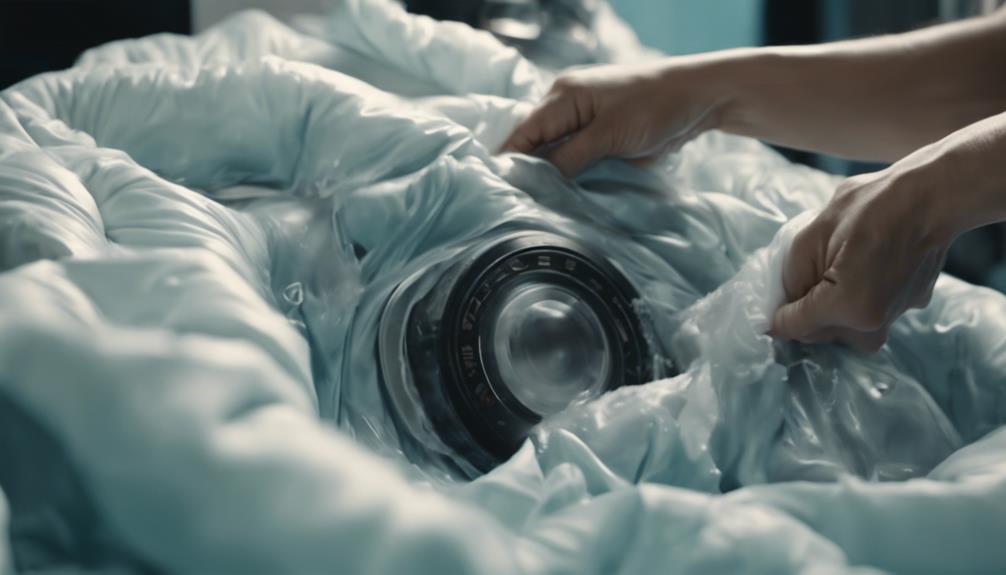
Professional cleaning of a down comforter may be recommended over DIY methods to guarantee proper care and maintenance. While washing your comforter at home may seem cost-effective, it can lead to damage if not done correctly.
Professional cleaning services can make sure that your comforter is cleaned thoroughly without risking harm to the delicate down fill. Dry cleaning, although it can prevent shrinkage, may also contain harsh chemicals that could damage the comforter. Confirm with the dry cleaner if they offer laundering services, as not all establishments do. The cost of dry cleaning a comforter typically ranges from $30 to $50, depending on the size of the comforter.
To reduce the frequency of washing your comforter, using a duvet cover is recommended. This can help protect the comforter from stains and dirt, ultimately prolonging its lifespan. Choosing professional cleaning over DIY methods can help maintain the quality and longevity of your down comforter.
How Agitators Affect Comforter Longevity

Agitators in washing machines pose a threat to the longevity of delicate down comforters due to their potential to cause uneven distribution and clumping of the filling. This can lead to a decrease in the comforter's fluffiness and insulation properties over time. The twisting motion of agitators may create wear and tear on the fabric of the comforter, reducing its lifespan by a considerable amount. To illustrate the impact of agitators on comforter longevity, consider the following:
| Aspect | Effect |
|---|---|
| Comforters care label | Agitators can damage the fabric and filling specified in the care label. |
| Agitator and tear | The twisting action of agitators can lead to tears in the comforter's fabric. |
| Washing capabilities | Agitator washing machines may not be suitable for delicate down comforters. |
It is important to follow the care instructions on the comforter's label and opt for washing machines without agitators to safeguard the longevity of your down comforter.
Tips for Down Comforter Maintenance
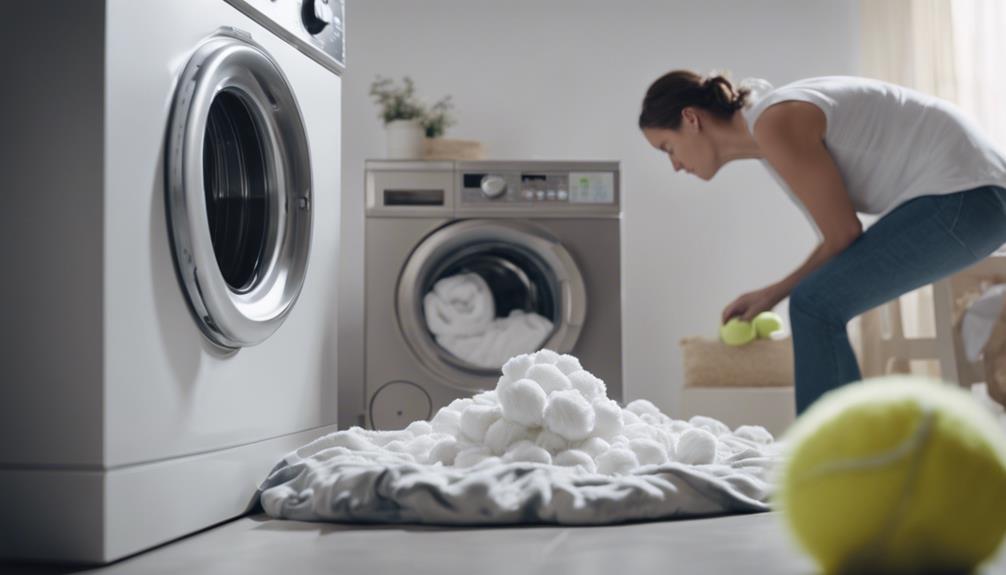
To maintain your down comforter's quality and longevity, regular cleaning and proper care are essential.
When it comes to washing your down comforter, it's important to choose a washing machine without an agitator. Agitators can be too harsh on the delicate down fill, causing it to clump together and lose its loft and warmth. Opt for a front-load or top-load washer for gentle and effective cleaning. These machines distribute water and detergent evenly, ensuring a thorough clean without damaging the down clusters.
By using a machine without an agitator, you help preserve the quality and lifespan of your down comforter. Remember to follow the manufacturer's care instructions, use a mild detergent, and avoid overloading the machine to maintain your comforter in top condition.
Regular cleaning and proper care will help guarantee that your down comforter stays fluffy, cozy, and in excellent condition for years to come.
Precautions for Washing Down Comforter
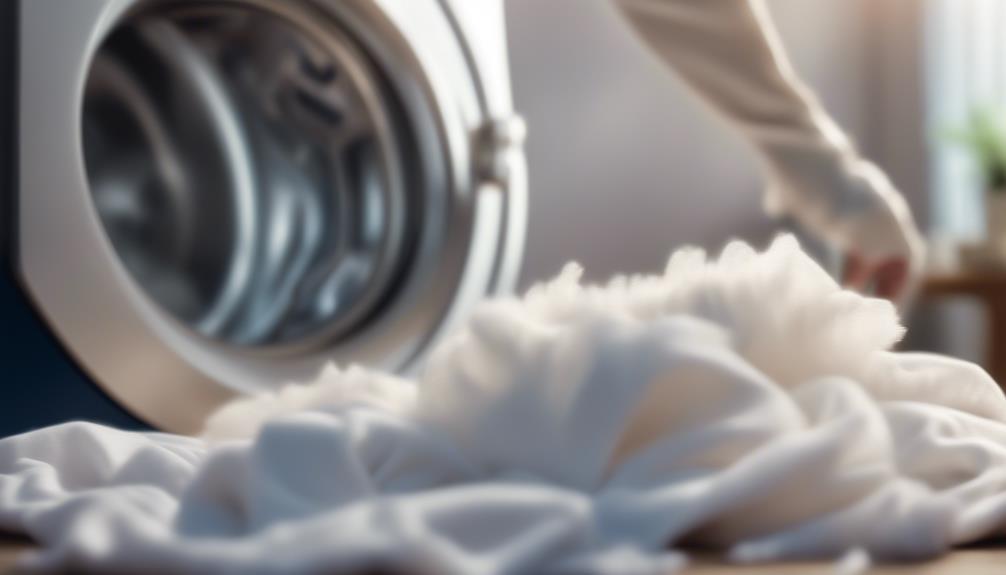
When washing a down comforter, it's essential to take precautions to protect the delicate down filling and maintain its quality. Before washing, check the care tag on the comforter for specific instructions. Some down comforters may require special care, such as dry cleaning.
If machine washing is suitable, consider using a duvet cover to protect the comforter during the washing process. A duvet cover acts as a barrier between the comforter and the agitator, reducing the risk of damage to the delicate down clusters.
Additionally, make sure to use a gentle cycle and mild detergent specifically designed for down-filled items. Avoid overcrowding the washing machine to allow the comforter to move freely and prevent excessive compression.
Final Thoughts on Agitator Washing
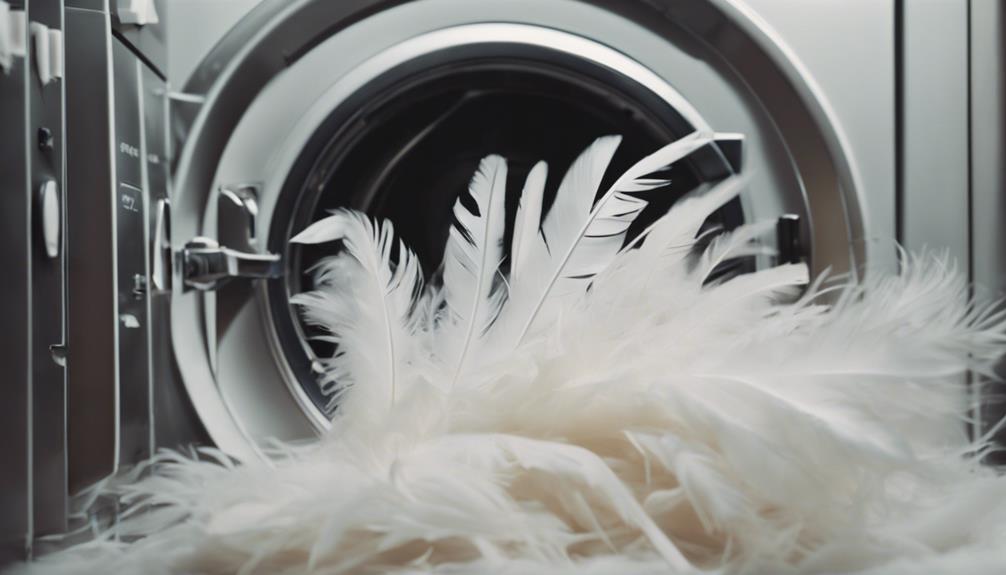
In considering the impact of agitator washing on down comforters, it becomes clear that gentler washing methods are crucial for maintaining the integrity of the delicate down fill.
Agitators can be harsh on the delicate down clusters, leading to potential damage such as clumping and loss of loft in the comforter. The twisting and turning motion of an agitator can also weaken the fabric and stitching of the down comforter over time, reducing its durability.
To guarantee the longevity and quality of your down comforter, opting for a washing machine without an agitator is recommended. These machines provide a more gentle cleaning process that helps preserve the fill and overall structure of the comforter.
Frequently Asked Questions
Can You Wash a Queen Comforter in a 4.5 Cu Ft Washer With Agitator?
Washing a queen comforter in a 4.5 cu ft washer with an agitator may not be ideal. The small size and presence of an agitator can lead to uneven washing and potential damage.
It's better to opt for larger washers without agitators for effective cleaning. Using a washer with an agitator for a queen comforter might cause compression and poor cleaning results due to tangling.
Consider a larger washer without an agitator for better outcomes.
What Is the Best Way to Launder a Down Comforter?
The best way to launder a down comforter is to opt for professional laundering over dry cleaning to avoid damage from harsh chemicals. Confirm if your dry cleaner offers laundering services, as not all do.
Using a duvet cover can decrease the need for frequent washing, extending the comforter's lifespan. Costs for dry cleaning range from $30 to $50 based on size.
Professional laundering is the safer choice for maintaining your down comforter.
What Happens if I Wash a Comforter in a Top Load Washer?
Washing a comforter in a top load washer can lead to potential issues. Agitators in these machines can be too rough on delicate items like down comforters, causing damage to the fill and fabric.
The aggressive spinning motion might cause tangling, clumping, and stress on the comforter's seams, risking tears or decreased quality. To maintain the comforter's integrity and longevity, it's best to avoid using a top load washer with an agitator.
Can You Wash a Blanket in a Washing Machine With an Agitator?
Yes, washing a blanket in a machine with an agitator can be damaging. Agitators may cause harm by creating friction and compression, leading to clumping and loss of fluffiness in the blanket.
For best care, it's advisable to avoid machines with agitators when washing delicate items like blankets. To guarantee longevity and quality, opt for a gentle cycle without an agitator to keep your blanket in top condition.
Is Washing a Down Comforter With an Agitator the Same as Dry Cleaning?
Washing a down comforter with an agitator is not the same as dry cleaning. While a dry cleaner washing comforter may be more gentle, washing at home can still be effective. However, it’s essential to follow care instructions to avoid damaging the comforter’s delicate feathers.
Conclusion
To wrap up, washing a down comforter with an agitator can cause damage to the delicate filling, leading to a shorter lifespan for your bedding.
It's best to opt for a washer without an agitator or consider professional cleaning services to make sure your comforter stays in top condition.
Remember, taking care of your down comforter won't only keep it fluffy and cozy but also save you money in the long run.
Choose wisely for a longer-lasting investment in comfort.
Mason – Your Product Expert Mason is your go-to product expert, carefully selecting each item in our collection to ensure it meets your comfort, functionality, and style needs. With his attention to detail and commitment to quality, he ensures that every product we offer enhances your home experience.
-
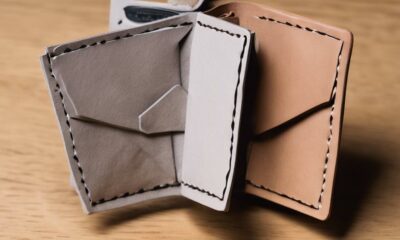
 Vetted6 months ago
Vetted6 months ago14 Best Personalized Father's Day Gifts for Your Husband – Show Him You Care
-

 Alfresco6 months ago
Alfresco6 months agoAlfresco Stacker Doors: Seamless Indoor-Outdoor Living!
-

 Vetted7 months ago
Vetted7 months ago15 Best EMS Foot Massagers for Neuropathy to Soothe Your Feet
-

 Craft and Textiles7 months ago
Craft and Textiles7 months ago15 Best Places to Buy Appliances for Your Home – Top Retailers Reviewed
-

 Tableware and Dining Accessories7 months ago
Tableware and Dining Accessories7 months agoWhat Is the Meaning of the Word Tableware
-
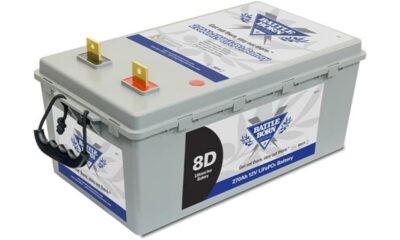
 Vetted5 months ago
Vetted5 months agoBattle Born Batteries Review: Reliable Power Solution
-

 Vetted5 months ago
Vetted5 months agoD-Link Switch Review: Lite Layer 3 Managed Networking
-

 Tableware and Dining Accessories7 months ago
Tableware and Dining Accessories7 months agoWhen Is Tableware on Sale at Hobby Lobby




























